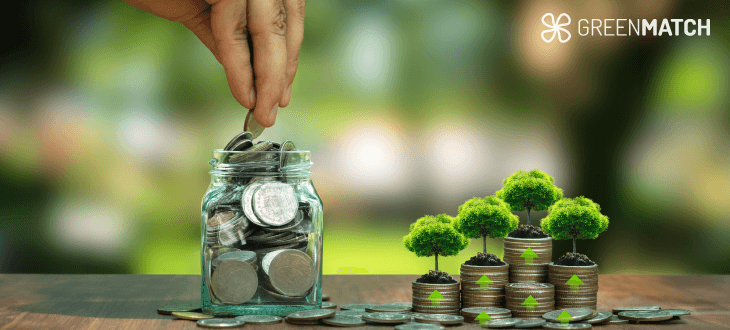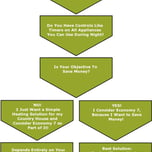- GreenMatch
- Blog
- How To Make Money By Going Green?
How To Make Money By Going Green?
Awareness of Climate Change Is Increasing
During the past years, there has been increasing awareness of climate change and sustainability. More and more governments, businesses and local communities are engaging with environmental initiatives and are focusing on "Going Green". This all started because humanity is suddenly experiencing the effects of decades of contamination, and therefore, many people have begun taking action to reduce their impact on the environment.
Nowadays, the environmental effects of this behaviour and some financial gains attract people to go green. With a more established and widespread objective of reducing carbon emissions, different incentives will mean extra money if you switch to greener habits.
In this post, we will focus on ways you can save and earn money by going green. This means you will learn about the booming green economy, the rise of sustainable products, and how simple lifestyle changes can lead to substantial savings and income.
From the benefits of green living to the specifics of green entrepreneurship, it emphasises the importance of adopting sustainable practices that can lead to significant savings and revenue generation.

Environmental Conservation and Financial Gain,
The worldwide push towards sustainability is driven by recognising our planet's severe environmental challenges. The need for action is clear, from the depletion of natural resources to the alarming pollution and global warming rates. Adopting green practices contributes to mitigating these challenges and offers a pathway to economic prosperity through savings, efficiency, and access to new markets.
The urgency to address environmental issues such as air pollution, land conservation, and global warming has never been greater. Air pollution alone is responsible for approximately 40,000 premature deaths annually. It highlights the critical need for sustainable practices.
Moreover, the global warming crisis, driven by human industrial and vehicular emissions, threatens to cause severe impacts, including rising sea levels and increased extreme weather events.
However, the shift towards sustainability is not merely a moral or environmental choice; it presents a unique opportunity for financial gain. Businesses and individuals can benefit financially by adopting green practices, from reducing energy costs to accessing new markets and customer segments prioritising sustainability.
Strategies for Going Green and Making Money
Invest in Renewable Energy:
Transitioning to renewable energy sources such as solar or wind power can significantly reduce energy costs in the long run. Government incentives and decreasing technology costs make renewable energy investments increasingly viable and profitable.
Renewable energy sources like wind, solar, and hydroelectric power are becoming increasingly important as the world seeks to reduce its carbon footprint and combat climate change.
According to the United Nations Environment Program, China has been the largest investor in renewable energy, with significant investments also coming from the United States and Japan.
By 2028, renewable energy sources are expected to account for over 42% of global electricity generation, with wind and solar PV doubling to 25%. This growth trajectory suggests a promising future for investors in the sector.
Why Invest in Renewable Energy?
Adopt Energy-Efficient Practices:
Simple changes like upgrading to LED lighting, improving insulation, and using energy-efficient appliances can substantially save utility bills.
Energy efficiency is using less energy to perform the same task, eliminating energy waste. This concept encompasses many actions, from upgrading to energy-efficient appliances and lighting to implementing more comprehensive measures such as improving building insulation and optimising industrial processes.
Why It Matters
The importance of energy efficiency cannot be overstated. It plays a pivotal role in combating climate change, reducing energy costs, and enhancing energy security. According to the International Energy Agency (IEA), energy consumption accounts for 60% of global greenhouse gas emissions, mainly from burning fossil fuels for electricity and heat generation.
Adopting energy-efficient practices contributes to environmental sustainability and can be financially beneficial. Governments and organisations worldwide offer various incentives for energy efficiency, including tax credits, rebates, and grants. These incentives can significantly offset the initial costs of implementing energy-efficient solutions.
The table below provides a concise overview of the global impact of energy efficiency on reducing greenhouse gas emissions and the potential financial savings:
| Factor | Impact |
| Greenhouse Gas Emissions Reduction | 60% of global emissions are due to energy consumption. |
| Potential Energy Cost Savings | Adopting energy-efficient practices can significantly reduce energy bills. |
| Global Renewable Energy Capacity | Aim to triple by 2030. |
| Energy Efficiency in the Electricity Sector | Renewable sources power nearly 30% of energy consumption. |
Sustainable Product Lines
Sustainable product lines are a growing trend in business, where companies focus on creating environmentally friendly and ethically produced products.
Businesses and individuals can tap into the growing market of consumers seeking eco-friendly products. Developing sustainable product lines or services can open new revenue streams and enhance brand loyalty among environmentally conscious customers.
This approach encompasses using sustainable materials, ethical labour practices, energy-efficient production methods, and packaging that minimises waste. The goal is to reduce the environmental impact while still providing high-quality products to consumers.
The products involve a life-cycle approach, considering every stage of the product's life, from raw material extraction to end-of-life disposal or recycling.
Sustainable Product Lines
| Sustainable Product | Material Used | Brand Example | Environmental Benefit |
| Clothing | Organic Cotton, Recycled Fibers | Taylor Stitch, Pact | Reduces waste, conserves resources |
| Footwear | Recycled Plastic, Natural Rubber | Rothy's, Veja | Lowers plastic pollution, promotes circular economy |
| Home Goods | Bamboo Fiber, Recycled Plastic | Ekobo | Minimizes waste encourages sustainable living |
| Gear | Recycled Polyester | Paravel | Reduces carbon footprint, supports recycling |
| Personal Care | Non-GMO, Organic Ingredients | Organic Basics | Avoids harmful chemicals, promotes organic farming |
Recycling and Waste Reduction
Implementing recycling programs and reducing waste not only benefits the environment but can also reduce operational costs. Selling recyclable materials or repurposing waste into new products can generate additional income.
Recycling and waste reduction are critical strategies for businesses and individuals aiming to go green and potentially make money. This approach involves collecting, sorting, and processing waste materials to transform them into new products, reducing the consumption of fresh raw materials, energy usage, and air and water pollution.
Why Invest?
This table provides the importance of recycling and its environmental impact. Here are some key statistics:
| Material | Global Recycling Rate | Notable Facts |
| Plastic | 6-9% of plastic waste recycled | 400 million tons of plastic waste produced yearly |
| Paper | 68% recycling rate | 91.4% of corrugated cardboard is recycled |
| Aluminum | High recycling rates | 7 million tons of aluminium are not recycled each year |
| Glass | 32% of glass bottles are recycled | Glass can be recycled endlessly without quality loss |
| E-Waste | 17.4% of e-waste recycled | Fastest-growing waste stream |
Green Certifications and Labels
Green certifications can make products and services more attractive to consumers and businesses looking to reduce their environmental impact, potentially leading to higher sales and market differentiation. They are designed to help consumers and businesses identify options that meet specific environmental standards, contributing to a more sustainable economy.
When considering certifications, businesses should align them with their sustainability goals and understand the standards. Certifications can aid in marketing and branding, especially when third-party verification is valued by customers or required by business partners.
According to the Whole Buiding Design Guide, you can get third-party certifications and independent evaluations that verify a product's green attributes, offering greater assurance to consumers and industry professionals. They are often recognised within comprehensive green building rating systems like LEED, Green Globes, BREEAM, and the National Green Building Standard.
Importance of Green Certifications
Green certifications can lead to numerous benefits, including:
Types of Green Certifications
The International Organization for Standardization (ISO) defines different green product certification labels:
To illustrate the impact of green certifications, here is a breakdown of it by type:
| Certification Type | ISO Standard | Focus Area | Recognised By |
| Type I | ISO 14024 | Multi-attribute | LEED, Green Globes |
| Type II | ISO 14021 | Single-attribute | Industry-specific |
| Type III | ISO 14025 | Comprehensive disclosure | EPDs, European market |
It is essential to avoid greenwashing by using misleading green claims, which may become a significant concern. It underscores the importance of carefully reviewing the details and requirements of green certifications to understand their actual value.
Participate in Carbon Credit Markets
Carbon credit markets are systems where carbon credits can be bought and sold. These credits are financial instruments representing the right to emit a certain amount of carbon dioxide or other greenhouse gases.
Companies that reduce carbon emissions can sell carbon credits in environmental markets, turning their sustainability efforts into direct financial gains. The goal is to incentivise emissions reduction by putting a price on carbon and encouraging companies and governments to invest in cleaner technologies and practices.
The value of traded global markets for carbon dioxide permits grew by 164 per cent to a record high, indicating the increasing value of carbon credits. This also presents financial opportunities for businesses and individuals to generate and sell credits.
Types of Carbon Markets
There are two main types of carbon markets:
How do Carbon Credits Work?
Carbon credits can be generated through various projects, such as renewable energy, energy efficiency improvements, and reforestation. These projects must be independently verified to ensure they effectively reduce or remove CO2 from the atmosphere. Once verified, credits can be sold on the carbon market.
Selling Carbon Credits
Entities can sell carbon credits in compliance carbon markets, voluntary carbon markets, and carbon exchanges. The process involves adhering to strict standards and protocols and often requires third-party verification to ensure the integrity of the credits.
Carbon Credit Market Value
| Year | Market Value (GBP) | Growth Rate |
| 2021 | 850 billion | - |
| 2022 | 760 billion | 164% |
| 2027 (Projected) | 2.4 trillion | 31% CAGR |
Perspective on Going Green
Reduce Your Energy Consumption
Going green is very much associated with reducing your carbon emissions. To do so, you should consider your energy consumption, what you buy and how you move. You should detect those activities that are most harmful to the environment and then think about how you could replace them with others that are less polluting.
You might have heard, for instance, that since cars are one of the main contributors to climate change, you should avoid using them as much as possible. One more original approach to this problem is carpooling – a new trend that translates into savings or even extra money.
Carpooling involves sharing a car with other people and splitting the fuel costs. This is useful in big cities where people must travel long distances daily. Different social networks allow you to contact others, offering their cars or looking for a ride. This is typically much less expensive than using the train or a car for only one passenger.
Something you can do to reduce your energy consumption significantly is to improve your home's insulation. In places like the UK, where cold and windy days are standard, much heat can be lost if the house is not insulated correctly. Check your roof, walls, windows and floors and see if their insulation can be improved. Double-glazed windows are an excellent option to keep your home warm. Sometimes, the government might offer grants to improve your home's insulation.
Switch to Green Sources of Energy
You can switch to renewable energy once you have maximised your energy consumption. Due to technological advances, it is now possible to switch to green energy sources, which are decently efficient and more affordable than they used to be. For example, you can install solar panels, solar thermal systems or heat pumps for residential purposes.
Some of these technologies will provide you with green electricity; others, like solar water heaters, are heating solutions for your home. Although they all indeed require a considerable initial investment, it is also true that once the system is installed, you will start saving money. Plus, the government's Feed Tariff (FIT) will pay you for every unit of electricity you generate, reducing your system's payback period.
After some years, the result will be a massive reduction in your carbon footprint and some extra money. The Renewable Heat Incentive is a similar scheme but applies to heating solutions (e.g., heat pumps and solar thermal).
So, you should start assessing your energy consumption and spot those not environmentally friendly activities. You can do many things to change your habits, and you will see environmental and financial benefits when going green!
Click GreenMatch.co.uk to get much green energy information and request customised quotes.
Conclusion
Going green is no longer just an environmental choice; it's a strategic financial decision. By embracing sustainable practices, individuals and businesses can contribute to environmental conservation while reaping significant economic benefits. The journey towards sustainability is a win-win scenario, offering a brighter future for our planet and prosperity for those who take action.
In an era where sustainability is increasingly top of mind, the opportunity to make money by going green has never been more accessible. Whether through energy savings, tapping into new markets, or participating in environmental markets, sustainability's potential for financial gain is vast and varied.
As we face environmental challenges, the dual benefits of going green provide a compelling case for individuals and businesses alike to adopt sustainable practices.
We strive to connect our customers with the right product and supplier. Would you like to be part of GreenMatch?




